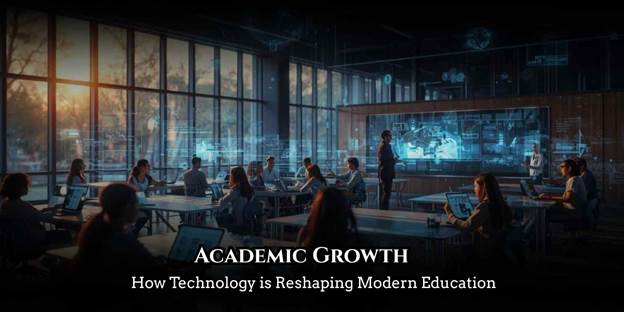In the age of digital transformation, academic growth has taken on a new meaning. The traditional classroom has expanded beyond physical boundaries, with online platforms, artificial intelligence, and virtual learning environments becoming central to how students learn and teachers teach. Academic growth today is not only about knowledge acquisition but also about adaptability, creativity, and technological fluency. As education evolves, digital tools are redefining learning outcomes and empowering learners of all ages.
This article explores how technology fosters academic growth through innovation, accessibility, and personalized learning. It delves into the history, importance, benefits, and challenges of digital education while examining real-world examples that highlight how technology-driven learning continues to shape the minds of tomorrow. The journey of academic growth in the digital era reflects a powerful fusion of knowledge, technology, and human potential.

Understanding Academic Growth in Modern Education
Academic growth refers to the measurable progress a student makes in knowledge, skills, and critical thinking over time. In the past, growth was primarily evaluated through test scores and standardized assessments. However, with technological advancement, academic growth now includes digital literacy, problem-solving abilities, and collaborative learning.
Digital learning, a secondary keyword, plays a pivotal role in this transformation. Online platforms such as Google Classroom, Coursera, and Khan Academy provide customized learning paths that cater to diverse learning styles. These digital environments not only enhance academic growth but also promote independent learning and global connectivity.
Historical Context: From Chalkboards to Cloud Learning
The journey toward digital academic growth began decades ago when computers first entered classrooms. Over time, innovations such as the internet, mobile apps, and e-learning platforms have completely revolutionized the education landscape. The rise of EdTech (education technology), another secondary keyword, has enabled real-time collaboration and access to educational content anytime, anywhere.
Today’s learners engage through interactive videos, gamified lessons, and virtual reality classrooms creating an environment that stimulates curiosity and deep understanding. This evolution has made academic growth a continuous, dynamic process rather than a static goal measured only by grades.
The Importance of Academic Growth in the Digital Age
In the modern world, academic growth is essential not just for academic success but for lifelong adaptability. The digital age requires individuals to be flexible thinkers capable of navigating a fast-changing world. Technology has democratized access to knowledge, allowing students from all backgrounds to achieve academic growth through equal learning opportunities.
Key importance of academic growth in digital learning:
- Promotes critical thinking through interactive problem-solving tools
- Encourages creativity with project-based virtual learning experiences
- Strengthens collaboration via global digital communities
- Fosters inclusivity and accessibility for students with diverse learning needs
By integrating technology in education, learners become active participants in their intellectual and personal development.
Related Article: Virtual Assessment: Redefining Evaluation in the Digital Learning Era
Benefits of Technology-Driven Academic Growth
Technology enhances academic growth in numerous ways by creating engaging, personalized, and measurable learning experiences. Here are some key benefits:
- Personalized learning: AI-driven platforms analyze progress and adjust lesson plans based on student performance.
- Enhanced engagement: Gamified apps and interactive lessons increase attention and motivation.
- Instant feedback: Students receive real-time insights to identify strengths and weaknesses.
- Global accessibility: Education becomes borderless, enabling learning beyond geographical limits.
- Skill development: Digital tools strengthen problem-solving, communication, and critical thinking.
By integrating these tools, academic growth becomes more efficient and meaningful, preparing learners for the challenges of a globalized digital economy.

Real-World Examples of Academic Growth Through Technology
Several successful case studies demonstrate how academic growth thrives in the digital age:
- Finland’s digital education model integrates technology into every aspect of learning, emphasizing creativity and collaboration.
- Google for Education tools have empowered millions of students and teachers to collaborate virtually, improving productivity and digital fluency.
- Massive Open Online Courses (MOOCs) on platforms like Coursera and edX promote self-paced learning, ensuring lifelong academic growth.
- AI tutors now provide customized learning experiences, helping students overcome difficulties faster.
These examples show that the fusion of technology and education drives not only intellectual progress but also emotional and social development.
Challenges in Achieving Digital Academic Growth
While technology offers immense opportunities for academic growth, it also presents challenges that must be addressed for equitable progress.
- Digital divide: Many students lack access to high-speed internet or modern devices.
- Quality control: Not all online content ensures accuracy or educational value.
- Distraction and screen fatigue: Excessive screen time can hinder concentration.
- Teacher training: Educators must develop the skills needed to integrate technology effectively.
Addressing these challenges requires investment in infrastructure, teacher training, and policies that promote digital inclusivity. Only then can the full potential of academic growth be realized across all educational systems.
Related Article: Tech Literacy: Building Digital Competence for a Connected Future
The Future of Academic Growth in Technology-Driven Learning
The future of academic growth lies at the intersection of artificial intelligence, data analytics, and immersive technology. Virtual classrooms, AI tutors, and augmented reality simulations are redefining engagement and interactivity.
Future trends expected to drive academic growth include:
- AI-assisted learning analytics for personalized education plans
- Virtual and augmented reality learning spaces for experiential knowledge
- Blockchain in education to verify learning credentials securely
- Gamified assessment systems that make learning enjoyable
These innovations signal a future where academic growth becomes limitless, powered by creativity, innovation, and digital empowerment.
Related Article: Digital Pedagogy: Transforming Education in the 21st Century
Conclusion
The digital era has revolutionized academic growth, redefining how knowledge is created, shared, and applied. Through the integration of digital learning and EdTech, education has evolved into a more dynamic, personalized, and inclusive experience. Yet, this transformation requires balance technology must serve as a bridge, not a barrier. By embracing innovative tools responsibly, educators and learners alike can ensure sustained academic growth that empowers future generations to thrive in a technology-driven world. Stay curious, keep learning, and explore how academic growth can shape your future in the digital age.
Pingback: Tech Literacy: Building Digital Competence for a Connected Future -
Pingback: Digital Pedagogy: Transforming Education in the 21st Century -